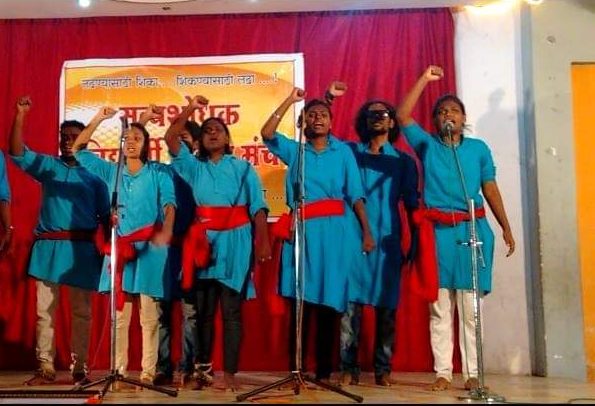Maharashtra has a long tradition of folk art culture of Kirtan, Abhang, Bharud, Gondhal, Povada, Lavani, Tamasha etc which have created their own places historically. This folk tradition, which started from poems on caste to composition on different social phenomenons, is an important link between social life and the formation of the Marathi mind.
Maharashtra’s poet saints have enriched and expanded Marathi literature which has contributed in talking to society and preaching when required. The legacy of disseminating Babasaheb Ambedkar’s thoughts through song and poetry is called Shahiri Jalsa.
Maharashtra has a very important and prominent history of Shahiri, a traditional art form originating in the 18th century. It is derived from an art form called “Tamasha” which is entertainment for upper castes and is performed by Dalit men and women, primarily from Mahar, Matang and Mang communities. Because it was a caste-based occupation of performing for entertainment of upper castes, it is exploitative in nature.
Folk Art to Resistance
During the rule of Shivaji Maharaj, Shahirs were a well respected part of the community. Jotirao Phule radically used the traditional Tamasha art form as an assertion against Brahmanism. He used this cultural form as a weapon against caste and patriarchy and started the Satyashodhak Jalsas in 1873. He also wrote a Powada about Shivaji Maharaj. He knew that cultural reform is as important as social reform and this tradition founded by him was continued by the Ambedkarite movement.
Also read: Dig Into The History Of The Casteist System You’ll Find Many Nodeeps
Jalsa was created using folk music in a simple manner in the dialect of the common people. During this period, many Shahirs made sincere efforts to spread Dalit unity and social rights through their simple yet forceful dialects. Dr. Babasaheb Ambedkar once gave a speech on the same stage as Lokshahir Bhimrao Kardak, after his Shahiri Jalsa. In that speech, he said, “A single song from a shahir is worth ten of my speeches.” A Shahir had a huge impact and used popular medium of songs, poems, and street plays for making people aware of their own enslavement.
Ambedkari Shahiri Jalsas started in 1927, where poets used a combination of Gan Gavlan to bring Ambedkarite thought to the fore.
Shahirs talk about caste discrimination and Brahminism, they talk about Shivaji Maharaj and Jotirao Phule’s thoughts. They also talk about how Dr. Ambedkar fought against casteism and spread the awareness in the masses about the messages that Babasaheb wanted to convey to them.
Dalit women from Mukta Salve to Nodeep Kaur have always contributed to anti-caste movement in various forms. In Maharashtra folk song always remain a form of assertion for women, like the famous folk song ‘jatyavarache Ovi‘, which women used to sing while grinding grain with stone.
There are many Shahiri songs in the anti-caste movement written by Dalit women Shahirs which talk about Dalit women’s issues. Hartsock rightly says, “The activities of women that place them in a socially underprivileged position can form the basis of a privileged epistemic standpoint, through which a deeper understanding of patriarchal institutions and ideologies can be reached.”
Also read: What Significance Did The 1995 Beijing Conference Hold For Dalit Women’s Movement?
One of the songs written by Shahir Sheetal Sathe,
“Kashi darodyachi dhura
maychya khandyavar ali
tiche dole panavale
nahi ekada hasali
Mazi may”
These songs tell us the lived experience of Dalit women.
Shahiri troupes are important part of contemporary movement of Dalit women. In part two of this article, meet four Dalit Shahir women like Sheethal Sathe, Suvarna Salve, etc. with notable contribution in the contemporary anti-caste movement in Maharashtra.
The experiences of Dalit women Shahir gives us an understanding of the challenges they face and the powers that oppress them and how they face it with fortitude. Dalit women’s struggles in this country begin from the moment they are born. When Dalit women work towards tearing this Manuwadi system down radically, it is frightened and tries to suppress their voices. But Dalit women are not fragile and their thoughts have immeasurable power which can destroy this casteist, Brahmanical system.
Megha Kshirasgar is an Ambedkarite Cultural Activist and is a member of Samata Kala Manch. She did Masters in Social Work (Dalit and Tribal Studies and Action) from Tata Institute of Social Sciences, Mumbai. You can find her on Facebook and Instagram.
The article was originally written in Marathi, translated in English by Sanika Dhakephalkar.
Featured Image Source: Megha Kshirasgar
This article has been updated and published in two parts. Read part two here.





